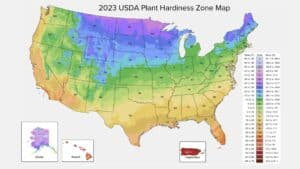
Most Common Landscaping Mistakes to Avoid
Landscaping is made easier by knowing what not to do. Here are the most common landscaping mistakes to avoid:
1. Lack of planning: Not having a clear plan before starting your landscaping project can lead to wasted time, money, and resources. Make sure to have a design in mind and consider factors like soil type, sunlight, and drainage before starting. While changing out seasonal annuals every few months is normal for large scale landscaping projects ranging from tree planting, water feature, patio, and pergola installation is something you want to get right the first time.
2. Overplanting: Planting too many trees, shrubs, or flowers too close together can lead to overcrowding and competition for space, nutrients, and sunlight. Give your plants enough room to grow to their full potential. Although mass plantings make for a big visual impact its not as sustainable for plant health or your wallet.

3. Ignoring maintenance needs: Landscaping requires ongoing maintenance to keep it looking its best. Neglecting regular tasks like watering, pruning, and fertilizing can lead to unhealthy plants and an unkempt appearance. Maintenance is an important part of your landscape design planning.
4. Choosing the wrong plants: It’s important to select plants that are well-suited for your climate, soil type, and sun exposure. Choosing plants that are not suited for your region can lead to their failure to thrive. The USDA Plant Hardiness map is a key resource in determining which plants are most likely to thrive in your region. Once you’ve considered the suitability of your choice of plants for your region it’s important to understand whether it will do well in the positions you are considering planting them in the landscape.
5. Poor soil preparation: Failing to prepare the soil properly before planting can hinder plant growth. Soil pH and the presence of macro and micro nutrients at specific levels are key factors in plant health and landscaping success or failure. Soil sample testing is free at the UF IFAS Agricultural Extension office in Duval County and elsewhere. Once you have some facts to work with regarding the organic makeup of your soil you’ll be better prepared to properly amend the soil with organic matter required by your landscape plantings. “4R Nutrient Stewardship provides a framework to achieve cropping system goals, such as increased production, increased farmer profitability, enhanced environmental protection and improved sustainability,” according to nutrientstewardship.org.
To achieve those goals, the 4R concept incorporates the:
- Right fertilizer source at the
- Right rate, at the
- Right time and in the
- Right place
6. Forgetting about functionality: It’s important to consider the functionality of your landscape design. Think about how you will use the outdoor space and plan accordingly. For example, if you have children or pets, you’ll need to incorporate areas for them to play. If you do lots of outdoor entertaining consider providing space for entertaining in your landscape plan. Our landscapes are increasingly considered an extension of our living space outdoors. Learn more from our tips for Creating a Resort-Like Atmosphere in Your Backyard.
7. Not considering long-term growth: Many plants start off small but can grow to be much larger over time. Make sure to consider their mature size and plan accordingly to avoid overcrowding and the need for future removal.
8. Lack of variety: Using a limited selection of plants can create a monotonous and boring landscape. Incorporate a variety of colors, textures, and heights to create a visually appealing and diverse landscape. While green is the predominant plant color there are many other colors and variegated green and white plants. Plants with varied leaf types and colors combined in layors of varied heights and growth patterns is best accomplished with careful landscape design planning.
9. Poor drainage: Inadequate drainage can lead to soggy soil, water pooling, and plant root rot. Ensure proper grading and consider solutions like installing drainage systems or using raised beds.
10. Inadequaate irrigation: Without an irrigation system landscape plants are dependent on Mother Nature’s rainfall and handwatering to survive. Even native plants that adapted over thousands of years to surviving with only rainfall did so under forest canopies and on plains that have been replaced with urban and suburban plots with different growing conditions. Learn more about the benefits of Irrigation and sprinkler systems.
11. Overreliance on chemicals: While herbicides, pesticides, and fertilizers are useful tools in landscaping they are often a bandaide on a problem that that would be more sustainably dealt with from improved understanding of gardening cultural best practices. Overuse of chemicals can harm beneficial insects, pollute water sources, and disrupt the natural balance of your garden.
By avoiding these common landscaping mistakes, you’ll be better prepared to create and maintain a thriving landscape that you can enjoy for years to come. Rockaway is your Northeast Florida one-stop shop for landscape design, installation, drainage, irrigation, outdoor living carpentry, and maintenance needs. Book a consultation and we will help you avoid the common landscaping mistakes and set you up for success!
From our office in Atlantic Beach and satellites throughout Northeast Florida, Rockaway Inc proudly serves both commercial and residential landscape design, maintenance, lawn care, irrigation, and outdoor living carpentry client needs in Jacksonville, St Augustine, Atlantic Beach, Neptune Beach, Jacksonville Beach, Ponte Vedra, Nocatee, St. Johns, and Fernandina Beach.
